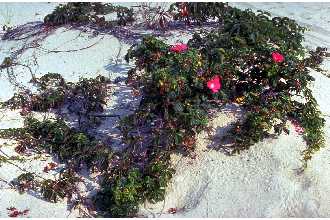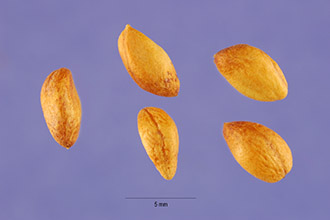Rosa rugosa Thunb. f. alba Rehder
Scientific Name: Rosa rugosa Thunb. f. alba Rehder

| General Information | |
|---|---|
| Usda Symbol | RORUA2 |
| Group | Dicot |
| Life Cycle | Perennial |
| Growth Habits | Subshrub |
| Native Locations | RORUA2 |
Plant Guide
Use soil moisture sensors to measure the soil moisture of Rosa rugosa Thunb. f. alba Rehder.
Fact Sheet
Uses
Traditionally used for its beautification qualities, rugosa rose’s value as an erosion control type plant has recently expanded to include sand dune stabilization. Its ability to withstand salt spray makes it a good choice to plant on sand dunes and roadsides. With its thorny stems, this shrub can be strategically established at locations to direct pedestrians between the sand dunes. The ripe fruits (hips) this plant produces are high in vitamin C, and can be made into teas, jams and jellies. To a lesser degree, this species offers some food and cover to deer, and small birds and mammals.
Status
Please consult the PLANTS Web site and your State Department of Natural Resources for this plant’s current status (e.g. threatened or endangered species, state noxious status, and wetland indicator values).
Invasiveness
This plant is considered noxious in some states. This plant may be invasive in some regions or habitats and may displace desirable vegetation if not properly managed. Please consult with your local NRCS Field Office, Cooperative Extension Service office, or state natural resource or agriculture department regarding its status and use. Invasive information is also available from the PLANTS Web site at plants.usda.gov.
Description
This erect, many branched, introduced, leafy shrub will grow to a height of four or five feet. The deciduous compound leaves are dark green and lustrous. The stout stems are densely covered with fine thorns and develop colonies from underground stems after a few years. The two to three inch diameter flowers will range from white to purple. Single blooms emerge all summer long. The flowers give rise to tomato-like red hips which range in size from ½ inch to 1½ inch in diameter. Heavy fruiting usually begins the second year after establishment.
Adaptation and Distribution
Distribution
Distribution
Rugosa rose is a native of China, but has a wide range of adaptability. Its best performance is on sandy, light textured soils, but it will do well on medium textured soils. This rose will not tolerate poorly drained sites. It is well adapted to coastal environments. William Skaradek USDA NRCS Cape May Plant Materials Center Cape May Court House, New Jersey Rugosa rose is distributed primarily throughout the Northeast. For a current distribution map, please consult the Plant Profile page for this species on the PLANTS Website.
Establishment
For successful establishment on roadbanks and sand dunes, vegetative establishment techniques are required, One year old bare-root seedlings or rooted cuttings are typically adequate for planting most sites; but where establishment is critical, container-grown 1 year old plants are recommended, All potentially competing vegetation should be removed or controlled prior to planting, unless it is critical to site stability, For optimum nursery production, standard raised bed propagation techniques can be utilized, After soil temperatures reach the 40s in fall, but before dropping into the 30s, apply a maximum of 3 grams pure live seed (PLS) per square foot area of bed to attain adequate production of quality seedlings, For the over-winter period, these beds should be mulched, Time released fertilizers, applied in late spring, have yielded the best growth results under nursery environments, Hardwood cuttings harvested during the dormant season, placed in a heated bench, work well to start rooted cuttings, Use soil moisture sensors to measure the soil moisture of Rosa rugosa Thunb. f. alba Rehder.,
Management
Periodic removal of older stems can improve the appearance of rugosa rose stands.
Environmental Concerns
There is some concern that this rose is becoming naturalized at the expense of native species. Where native roses occur in local stands, rugosa rose should be used with discretion. Cultivars, Improved, and Selected Materials (and area of origin) Many improved horticultural varieties are grown for beautification purposes. Only one cultivar has been selected and released specifically for use on sand dune stabilization. That cultivar is ‘Sandy’ (DE, MD, MA, NJ) which was released in 1992 by the Cape May PMC. ‘Sandy’ is a polycross of twelve separate collections. Foundation seed and seed orchard stock can be obtained by commercial nurseries from the Cape May PMC. This released conservation variety and others are available from various commercial nurseries for use by the public.
Plant Traits
Growth Requirements
| Temperature, Minimum (°F) | -33 |
|---|---|
| Adapted to Coarse Textured Soils | Yes |
| Adapted to Fine Textured Soils | No |
| Adapted to Medium Textured Soils | Yes |
| Anaerobic Tolerance | Low |
| CaCO3 Tolerance | Medium |
| Cold Stratification Required | Yes |
| Drought Tolerance | High |
| Fertility Requirement | Medium |
| Fire Tolerance | Medium |
| Frost Free Days, Minimum | 140 |
| Hedge Tolerance | Low |
| Moisture Use | Medium |
| pH, Maximum | 7.5 |
| pH, Minimum | 5.5 |
| Planting Density per Acre, Maxim | 2700 |
| Planting Density per Acre, Minim | 1210 |
| Precipitation, Maximum | 60 |
| Precipitation, Minimum | 34 |
| Root Depth, Minimum (inches) | 14 |
| Salinity Tolerance | Low |
| Shade Tolerance | Intolerant |
Morphology/Physiology
| Bloat | None |
|---|---|
| Toxicity | None |
| Resprout Ability | Yes |
| Shape and Orientation | Semi-Erect |
| Active Growth Period | Spring and Summer |
| C:N Ratio | High |
| Coppice Potential | No |
| Fall Conspicuous | Yes |
| Fire Resistant | No |
| Flower Color | Red |
| Flower Conspicuous | Yes |
| Foliage Color | Green |
| Foliage Porosity Summer | Dense |
| Foliage Porosity Winter | Moderate |
| Foliage Texture | Coarse |
| Fruit/Seed Conspicuous | Yes |
| Nitrogen Fixation | None |
| Low Growing Grass | No |
| Lifespan | Long |
| Leaf Retention | No |
| Known Allelopath | No |
| Height, Mature (feet) | 5.0 |
| Height at 20 Years, Maximum (fee | 5 |
| Growth Rate | Moderate |
| Growth Form | Rhizomatous |
| Fruit/Seed Color | Red |
Reproduction
| Vegetative Spread Rate | Moderate |
|---|---|
| Small Grain | No |
| Seedling Vigor | Medium |
| Seed Spread Rate | Slow |
| Fruit/Seed Period End | Fall |
| Seed per Pound | 66000 |
| Propagated by Tubers | No |
| Propagated by Sprigs | No |
| Propagated by Sod | No |
| Propagated by Seed | Yes |
| Propagated by Corm | No |
| Propagated by Container | Yes |
| Propagated by Bulb | No |
| Propagated by Bare Root | Yes |
| Fruit/Seed Persistence | Yes |
| Fruit/Seed Period Begin | Spring |
| Fruit/Seed Abundance | High |
| Commercial Availability | Routinely Available |
| Bloom Period | Mid Spring |
| Propagated by Cuttings | No |
Suitability/Use
| Veneer Product | No |
|---|---|
| Pulpwood Product | No |
| Protein Potential | Medium |
| Post Product | No |
| Palatable Human | No |
| Palatable Graze Animal | Low |
| Palatable Browse Animal | Low |
| Nursery Stock Product | Yes |
| Naval Store Product | No |
| Lumber Product | No |
| Fodder Product | No |
| Christmas Tree Product | No |
| Berry/Nut/Seed Product | No |

